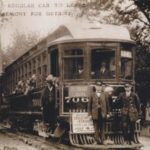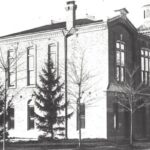In the early 1880’s, Frederick P. Currier wished to lower his shipping costs and shorten his delivery times. Currier provided financial support to Henry G. McMorran, who was the general manager of the Port Huron & Northwestern Railroad, to get a narrow gauge (3 foot) rail line constructed from Port Huron through Memphis to Almont. In January 1882, the Port Huron & South Western Railway was formed as a subsidiary of the Port Huron & Northwestern Railway with the purpose of constructing the line to Almont. Construction began almost immediately and the first train ran on October 3, 1882. With the completion of the line, the Port Huron & South Western Railway was consolidated into the Port Huron & Northwestern Railway (PH&NW). It was planned that the line would eventually be extended to Pontiac and then Detroit but nothing ever became of those plans. The PH&NW operated narrow gauge rail lines throughout Michigan’s thumb.
The line ran from Port Huron to Kimball, Burns, Lamb, and Wales to Memphis. It continued to Doyle, Berville, Smiths (Allenton), and ended in Almont. The rail line ended in Almont on the west side of Van Dyke which is now Murphy Memorial Park. The turntable was located west of Van Dyke and the Farnum Drain (now west of Edward Murphy Memorial Park). On the east side of Van Dyke in front of the elevator were the pens for holding livestock and the water tower was to the south of the railroad line.
The line was used both for passengers and freight. Originally, a passenger train arrived at night and returned to Port Huron in the morning. Freight from Almont consisted mainly of agricultural products (grains, beans, corn, and fruit) and the agricultural implements manufactured by the Currier Agricultural Works. The freight coming to Almont was coal, lumber, and materials for the Currier facility. Leon Bishop’s coal yard was located east of the lumber yard.
On April 1, 1889, the Port Huron & Northwestern Railway was purchased by the Flint and Pere Marquette Railroad (F&PM). In the 1890’s, the F&PM converted all of the narrow gauge lines north of Port Huron to standard gauge tracks (4 feet-8.5 inches), which left only the Almont line as narrow gauge.
The 1890’s were a time of consolidation of smaller railroads into large, more extensive companies. On May 20, 1899, the Flint & Pere Marquette Railroad Company, the Detroit Grand Rapids and Western Railroad Company and the Chicago West Michigan Railroad Company agreed to merge. They completed the re-organization of the company on November 1, 1899 and began operation on January 1, 1900 as the Detroit and Pere Marquette Railroad. The company name was eventually shortened to just the Pere Marquette Railroad.
In May 1903, the Almont line was converted to standard gauge. This ushered in the most profitable time for the railroad. However, after the end of World War I, the development of delivery trucks and the construction of the state “trunk line” roads led to a substantial decline in the use of the railroad
Freight service continued throughout the 1930’s but the frequency was reduced until at the end of the decade, only one train a week was scheduled. The change in emphasis from agricultural business to automotive production by the Almont Manufacturing Company at the start of the 1920’s also contributed to the lack of need for the railroad’s freight service. Finally on December 3, 1941, Pere Marquette filed the paperwork to abandon the line. The Interstate Commerce Commission approved the abandonment filing on December 12, 1941. With the onset of World War II, the tracks were almost immediately removed. The railroad roadbed was also removed. Most of the path was plowed under and became part of farmer’s fields. Some sections were used as farm lanes or driveways. Some sections can still be seen as the tree lines between fields. All of the bridges were removed.




